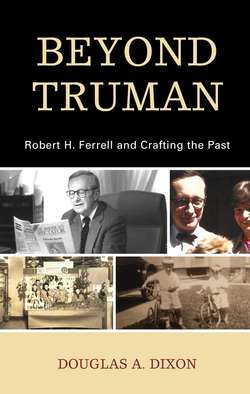Читать книгу Beyond Truman - Douglas A. Dixon - Страница 10
На сайте Литреса книга снята с продажи.
ОглавлениеIntroduction
So why a book titled Beyond Truman: Robert H. Ferrell and Crafting the Past? It is almost unimaginable for any devotee of twentieth-century presidential biography to be unaware of Robert Ferrell. Well known for painting intimate details of political elites, famous and infamous, the Hoosier author steadied his microscope on President Truman more than most. Other presidents had to endure the stethoscope, one might say, of Ferrell’s search for medical malpractice. Diplomats and soldiers also did not elude the historian’s investigative eye. Yet, looking at the content of books alone misses the larger story, the intrigue, or better said, the man, the motivations, even the mischief of Ferrell and his times.
This Buckeye-turned-Hoosier found his way of thinking about and doing history at odds with a growing chorus of colleagues during his career. A self-described “traditionalist” or empiricist, he criticized the efforts of many postmodernists, the New Left, and social and cultural historians because they were upending the basis of what he, and many others, believed was legitimate, worthwhile, ethical history. Concentrating on the subfields of American diplomacy, the presidency and war, itself, was a sign that his training owed much to the nineteenth-century Leopold von Ranke school, which emphasized that statecraft was the legitimate area of historical inquiry and that state documents were the proper sources to excavate. Elite, Eurocentric, and top-down foci were also part of this mix.
Various strands of postmodernism challenged the Indiana University historian’s approach to the past. Ironically, Ferrell’s experiences soldiering in the Second World War, application to Yale, or courtship of lifetime mates, explored in the following chapters, serve as exemplars of the potency of postmodernist claims. Serving in the Army Air Force in the unique way that Staff Sergeant Ferrell did provides alternatives to mainstream narratives of the war; finding his way into an Ivy League graduate history program defies one’s attempt at a unified, singular, coherent explanation; defining Ferrell’s persona leading to marriage points to multiple realities of truth. So, though Ferrell defended the empirical tradition against these challenges, some evidentiary trails of his life reinforce his opponents’ beliefs—illusive truthful essences of the past, multiple realities, male-dominated history, the merits of bottom-up history, and so on. Broadly speaking, postmodernism rattled Ferrell’s orientation toward historical topics, sources, perspectives, claims to a singular, truthful historical reality, and disciplinary boundaries; yet his lived experiences might be considered at odds with traditional historical and social values. These debates continue to be worthy of our attention.
The stories shared here also reveal something of the character, one might say bias, that inevitably lay behind the public face of historians like Ferrell. Truth seekers claim that the experiences, background, values, or demographic traits that historians bring to the task influence the topics explored, sources used, the topical framework or arguments proffered, in the end, the illusion some project of objectivity. Ferrell’s characteristics and background match those traits, in many ways, of President Harry Truman (as examined in chapter 4). Thus, it is not too difficult to imagine that this, in part, may explain why the president’s most prolific biographer was apologist for the struggles of, as well as advocate for ranking highly, the thirty-third chief executive. Readers can see how well the Indiana storyteller adhered to several conventional criteria of historical objectivity defined by the profession in other instances too.
One can find plenty of enjoyment solely in reading the intrigue that infused Ferrell’s world. Overall, this book illuminates in a personal way the ongoing struggles that producing history can present to the storyteller. The lessons of historian Ferrell continue to inform current practices, even today.
